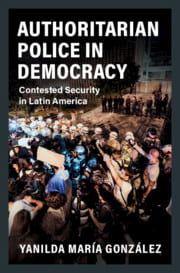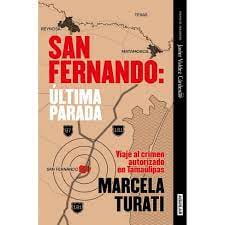A Review of Authoritarian Police in Democracy

Authoritarian Police in Democracy: Contested Security in Latin America by Yanilda María González. Cambridge University Press, 2021, 355 pages.
This deeply researched book suggests to its reader a truly tragic paradox: the possibility that under certain conditions, democratic institutions and processes may undermine rather than strengthen the rule of law.
Building on grounded empirical analysis of brutal policing practices and efforts to reform them in several Latin American countries that transitioned from authoritarian rule, Yanilda María González shows how and why abusive security institutions and extra-legal police behavior may persist despite formal democratization. More troubling although equally provocative is her argument that the very nature and logic of democratic processes may be precisely what makes reforming such corrupt practices so difficult to achieve.
With a focus on reform policies intended to regulate or monitor police in Argentina, Brazil and Colombia, González—trained as a political scientist and now an Assistant Professor at the Kennedy School of Government— develops a careful, precise and analytically powerful conceptual apparatus to account for the ways that citizen preferences and the electoral calculations of governing officials may actually sustain “authoritarian coercion.” Although the subject of this important book is not rule of law per se, but rather the nature of police institutions and practices, it nonetheless sheds light on the legal versus extra-legal behavior of security forces charged with upholding constitutional and legislative mandates intended to guarantee rights, sustain regime legitimacy and guarantee social accountability within contemporary Latin American democracies.
Beyond defining the practices that constitute authoritarian versus democratic coercion, González sheds light on why it is so difficult to achieve the latter—and in many ways her argument could be interpreted as suggesting that true accountability in police operations is near impossible to ensure precisely because of democracy. To reframe this argument in González’s own words: “the cases analyzed throughout this book demonstrate that both the persistence of violent, corrupt, and ineffective police forces and concerted police reform efforts to promote democratic coercion may represent exercises in democratic responsiveness” (p. 316).
Democratic procedures, in short, limit substantive police reform. To be sure, González is not raising questions about the normative importance of democracy, nor is she questioning the importance of reform efforts. But she is both savvy and cautious in her analysis of their effectiveness. Indeed, her case study materials show deep knowledge and sympathy for the immense struggle of civil society actors, as well as for the fraught bureaucratic and political decision-making of government authorities who want to respond to citizens and control or purge abusive police. In all its complexity, Authoritarian Police in Democracy reveals the tough battle ahead for so many Latin American countries that seek to move beyond the tragically violent and unscrupulous policing legacies of the past. Even so, given the very small number of limited—and indeed ephemeral—successes chronicled in this account, González’s conclusions constitute both an intellectual wake-up call and an existential challenge to scholars, policymakers and police reform advocates who believe that the pathway towards a more vibrant rule of law is guaranteed by strengthening democratic institutions and processes. It should be required reading for anyone who seeks to understand why reform is so difficult.
The book deploys a rigorous and careful methodology informed by a deep understanding of the complexities of the subject and high-level engagement with the literature on police reform, on institutional change and democratic politics in Latin America and beyond. It selects cases that allow a comparison within and between shared governance arrangements, selecting countries that represent both unitary and federal systems in which military strength may have been great but histories of democratic versus authoritarian rule also diverged, thus allowing her to conclude that successful (or failed) efforts at reform owe to more than regime types or historical legacies.
In addition, despite making a larger analytical distinction between authoritarian and democratic coercion, González acknowledges the bluntness of these categories and shrewdly suggests that they should be understood on a continuum. This leads her to develop a range of metrics and indices to assess the extent to which police reforms actually move a country from one end of the continuum to the other. González thus identifies four categories of police reform: a) `marginal’ policy changes, mainly having to do with the creation of additional oversight agencies; ‘b) operational’ shifts in police practices; c) `structural’ reforms that alter organizational systems and rules; and d) `external control’ changes that modify internal structures and practices. This final set of reforms are most likely to support a transition from authoritarian to democratic coercive practices; yet they also are the least likely among her cases, thus reinforcing her larger point about the difficulties of truly effective police reform.
In assessing the factors that do lead to the latter, González is both astute and savvy in showing how the fragmentation of citizen preferences is as serious a constraint on fundamental reform as is the skittishness of authorities to push back against security agents and institutions. In this sense, the book highlights what most scholars of the Latin American security sector already know: those who control the means of coercion have inordinate `structural power’ (p.31), in substantive if not formal political terms. Even states that seek to use police and military agents on their own behalf, to consolidate democratic gains, are frequently hamstrung/held hostage by these very same forces, a constraint explained by their fears of the social and political fallout that would accrue if security were withdrawn. Even so, Authoritarian Police in Democracy adds much needed complexity to this general assessment by sharing grounded ethnographic and interview material that reveals how and why the struggles undertaken by citizens and authorities to push back against such constraints can be successful.
As a scholar deeply interested in this topic, I might have liked more focus on the concept of fragmentation as applied to the security forces themselves. González’s use of the convergence-fragmentation conceptual dichotomy to describe the conditions under which a diverse array of citizen preferences often prevents authorities from enacting serious police reform is central to her argument. One also wonders whether fragmentation would work the same way within the security sector itself. Would it enable or constrain authoritarian coercive practices and effective police reform processes? My own work on Mexico suggests the latter but being able to address this issue in the context of comparative research would be absolutely essential. González does in fact pay some attention to the complex institutional relationship between police and military in her three countries, and its bearing on the differences in outcomes might be worth closer attention.
On a final note, one cannot help but reflect on the book’s own conclusion, in which the reader is told that the few successful cases of “hard-fought and far-reaching” police reform so well-chronicled in this book (i.e. in Colombia and Buenos Aires Province in the late 1990s) “faced a swift backlash and important components of the reforms were dismantled shortly after being enacted” (p.301). This recognition leads González herself to raise questions about the durability of police reform even when it is successful.
Whether the ephemerality of the successes is a product of the historical period in which the research was undertaken or something about the cases themselves is hard to know. But the decision to end with a reflection on the Bolsonaro regime and its deployment of authoritarian coercion in contemporary Brazil suggests that conditions today may be no different than in the past when it comes to breaking the continuity of authoritarian policing legacies. If this is so, the challenge is great for those of us who seek to move beyond the abusive tragedies of the past and to use democracy or other accountability measures to strengthen rule of law and prepare new pathways for justice and the elimination of indiscriminate violence perpetrated against the peoples of Latin America. This book lays a marvelous foundation for all scholars, policymakers, and activists who are committed to advancing this critical mission, and González should be applauded for her wisdom, erudition, and savvy in sharing both the barriers and enablers to achieving such goals.
Fall 2021, Volume XXI, Number 1
Diane E. Davis is Charles Dyer Norten Professor of Regional Planning and Urbanism in the Department of Urban Planning and Design at Harvard’s Graduate School of Design (GSD). Trained as a political sociologist, she teaches courses and conducts research on the political economy of urbanization, the relations between urbanization and national development, and new territorial forms of sovereignty in Latin America. In recent years she has published a range of articles on urban governance, social movements, urban violence, and disaster recovery, with special attention to Mexico, a country she has studied for the last several decades. Her current book project is a history of police corruption in Mexico.
Related Articles
A Review of Default: The Landmark Court Battle over Argentina’s $100 Billion Debt Restructuring
In February 2019, I found myself serving as the special attorney general for the then newly recognized interim government of Venezuela, tasked with addressing more than 50 claims before the U.S. courts stemming from the $140 billion debt inherited from Hugo Chávez and Nicolás Maduro.
A Review of Until I Find You: Disappeared Children and Coercive Adoptions in Guatemala
A student in my “Introduction to Cultural Anthropology” course at the University of Delaware approached me several weeks ago, after hearing about my long-term research in Guatemalan communities, to tell me that they were born there, in Guatemala.
A Review of San Fernando: Última Parada, Viaje al crimen autorizado en Tamaulipas
One of Mexico’s best investigative journalists, Marcela Turati, takes readers to terrorized and traumatized San Fernando, a town known for dozens of mass graves, and exposes the depths of criminal brutality and official corruption that hid the bodies and the truth for years.




